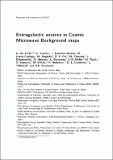Por favor, use este identificador para citar o enlazar a este item:
http://hdl.handle.net/10261/139908COMPARTIR / EXPORTAR:
 SHARE SHARE
 CORE
BASE CORE
BASE
|
|
| Visualizar otros formatos: MARC | Dublin Core | RDF | ORE | MODS | METS | DIDL | DATACITE | |

| Título: | Extragalactic sources in Cosmic Microwave Background maps |
Autor: | Zotti, G. de; González-Nuevo, J. CSIC ORCID; López-Caniego, M. CSIC ORCID; Negrello, Mattia; Cai, Z. Y.; Clemens, M. S.; Delabrouille, Jacques; Herranz, D. CSIC ORCID ; Bonavera, Laura CSIC ORCID; Melin, J. B.; Tucci, M.; Serjeant, S.; Clements, D. L. | Fecha de publicación: | 2015 | Editor: | Institute of Physics Publishing | Citación: | Journal of Cosmology and Astroparticle Physics 06: 018 (2015) | Resumen: | We discuss the potential of a next generation space-borne CMB experiment for studies of extragalactic sources with reference to COrE+, a project submitted to ESA in response to the call for a Medium-size mission (M4). We consider three possible options for the telescope size: 1 m, 1.5 m and 2 m (although the last option is probably impractical, given the M4 boundary conditions). The proposed instrument will be far more sensitive than Planck and will have a diffraction-limited angular resolution. These properties imply that even the 1 m telescope option will perform substantially better than Planck for studies of extragalactic sources. The source detection limits as a function of frequency have been estimated by means of realistic simulations taking into account all the relevant foregrounds. Predictions for the various classes of extragalactic sources are based on up-to-date models. The most significant improvements over Planck results are presented for each option. COrE+ will provide much larger samples of truly local star-forming galaxies (by about a factor of 8 for the 1 m telescope, of 17 for 1.5 m, of 30 for 2 m), making possible analyses of the properties of galaxies (luminosity functions, dust mass functions, star formation rate functions, dust temperature distributions, etc.) across the Hubble sequence. Even more interestingly, COrE+ will detect, at |b| > 30°, thousands of strongly gravitationally lensed galaxies (about 2,000, 6,000 and 13,000 for the 1 m, 1.5 m and 2 m options, respectively). Such large samples are of extraordinary astrophysical and cosmological value in many fields. Moreover, COrE+ high frequency maps will be optimally suited to pick up proto-clusters of dusty galaxies, i.e. to investigate the evolution of large scale structure at larger redshifts than can be reached by other means. Thanks to its high sensitivity COrE+ will also yield a spectacular advance in the blind detection of extragalactic sources in polarization: we expect that it will detect up to a factor of 40 (1 m option) or of 160 (1.5 m option) more radio sources than can be detected by Planck and, for the first time, from several tens (1 m option) to a few hundreds (1.5 m option) of star forming galaxies. This will open a new window for studies of the global properties of magnetic fields in star forming galaxies and of their relationships with star formation rates. | Descripción: | arXiv:1501.02170v2.-- et al. | Versión del editor: | https:/doi.org/10.1088/1475-7516/2015/06/018 | URI: | http://hdl.handle.net/10261/139908 | DOI: | 10.1088/1475-7516/2015/06/018 | Identificadores: | doi: 10.1088/1475-7516/2015/06/018 e-issn: 1475-7516 |
| Aparece en las colecciones: | (IFCA) Artículos |
Ficheros en este ítem:
| Fichero | Descripción | Tamaño | Formato | |
|---|---|---|---|---|
| CosmicMB.pdf | 715,7 kB | Adobe PDF |  Visualizar/Abrir |
CORE Recommender
SCOPUSTM
Citations
10
checked on 28-mar-2024
WEB OF SCIENCETM
Citations
16
checked on 24-feb-2024
Page view(s)
242
checked on 23-abr-2024
Download(s)
239
checked on 23-abr-2024
Google ScholarTM
Check
Altmetric
Altmetric
NOTA: Los ítems de Digital.CSIC están protegidos por copyright, con todos los derechos reservados, a menos que se indique lo contrario.
